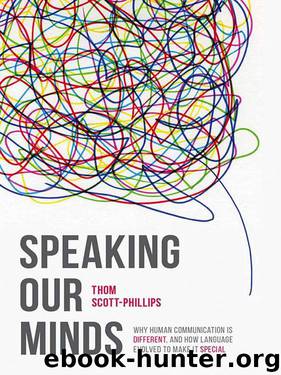Speaking Our Minds: Why human communication is different, and how language evolved to make it special by Thom Scott-Phillips

Author:Thom Scott-Phillips [Scott-Phillips, Thom]
Language: eng
Format: epub
ISBN: 9781137315632
Publisher: Palgrave Macmillan
Published: 2014-11-02T23:00:00+00:00
4.4 Do great apes communicate with natural codes?
If great ape communication is not ostensive, then does that imply that great ape communication must, therefore, be an instance of coded communication? There is, after all, no other account of the very possibility of communication (see Chapter 1). In this section I will present arguments that the code model is a good description of great ape communication. I should immediately reiterate that a communication system built upon codes need not be simple or unsophisticated. On the contrary, a system of coded communication could, in principle, be rather sophisticated indeed. In fact, we shall see in this section that this is likely the case with great ape communication.
To flesh this idea out, let me begin with the currently live debate about the origins of great ape gestural communication (see Liebal & Call, 2012 for a review). For some time now, the main explanation of this has been the process of ontogenetic ritualization (see §2.3). Several researchers have argued that great ape gestures originated exclusively or at least predominantly in this way (e.g. Call & Tomasello, 2007). The main objection to this claim has been that if the gestures were ontogenetically ritualized, then the actions involved should closely match those of the presumed original actions – but some detailed analyses suggest that this is not the case (Genty et al., 2009; Hobaiter & Byrne, 2011). The authors of these analyses thus argue that most gestures are part of a species-typical repertoire (ibid.). Debate continues: those that advocate the ontogenetic ritualization hypothesis have responded with new analyses in which they track instances of ontogenetic ritualization over time, and hence show that it is responsible for the creation of at least some great ape gestures (Halina et al., 2013). By the time you read this, the literature will likely have advanced further still.
Table 4.2 A comparison of children’s, dogs’, and chimpanzees’ abilities with respect to the different components of ostensive communication. There are significant methodological challenges associated with many (perhaps all) of the entries that have not yet been directly studied. For some entries there is more than one relevant study; additional references are given in the main text.
Download
This site does not store any files on its server. We only index and link to content provided by other sites. Please contact the content providers to delete copyright contents if any and email us, we'll remove relevant links or contents immediately.
Cecilia; Or, Memoirs of an Heiress — Volume 1 by Fanny Burney(32413)
Cecilia; Or, Memoirs of an Heiress — Volume 3 by Fanny Burney(31824)
Cecilia; Or, Memoirs of an Heiress — Volume 2 by Fanny Burney(31808)
The Lost Art of Listening by Michael P. Nichols(7388)
Asking the Right Questions: A Guide to Critical Thinking by M. Neil Browne & Stuart M. Keeley(5601)
We Need to Talk by Celeste Headlee(5522)
On Writing A Memoir of the Craft by Stephen King(4847)
Dialogue by Robert McKee(4305)
Pre-Suasion: A Revolutionary Way to Influence and Persuade by Robert Cialdini(4119)
I Have Something to Say: Mastering the Art of Public Speaking in an Age of Disconnection by John Bowe(3832)
Elements of Style 2017 by Richard De A'Morelli(3300)
The Book of Human Emotions by Tiffany Watt Smith(3221)
Fluent Forever: How to Learn Any Language Fast and Never Forget It by Gabriel Wyner(3011)
Name Book, The: Over 10,000 Names--Their Meanings, Origins, and Spiritual Significance by Astoria Dorothy(2926)
Good Humor, Bad Taste: A Sociology of the Joke by Kuipers Giselinde(2890)
Why I Write by George Orwell(2863)
The Art Of Deception by Kevin Mitnick(2721)
The Grammaring Guide to English Grammar with Exercises by Péter Simon(2698)
Ancient Worlds by Michael Scott(2607)
